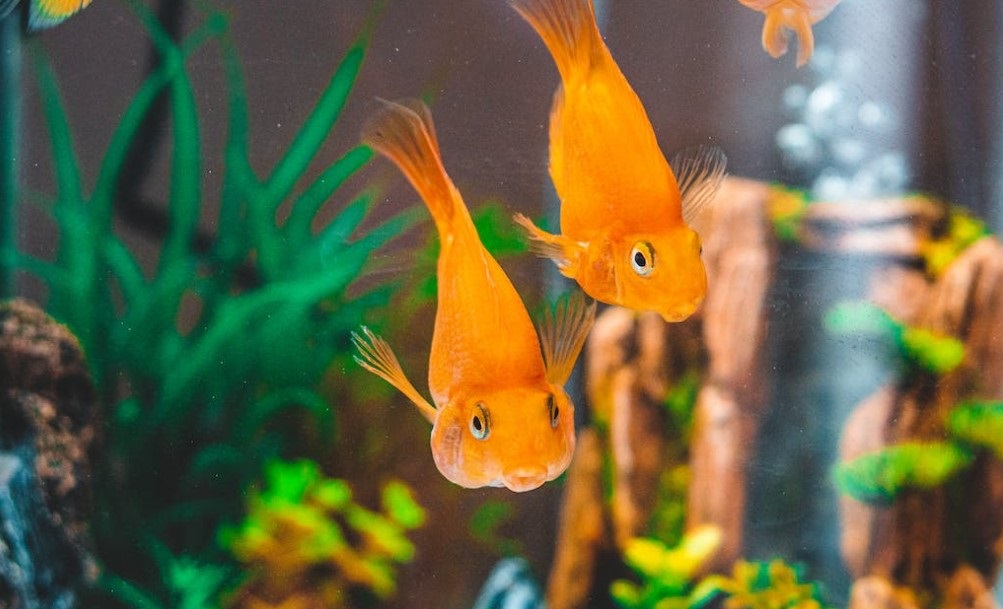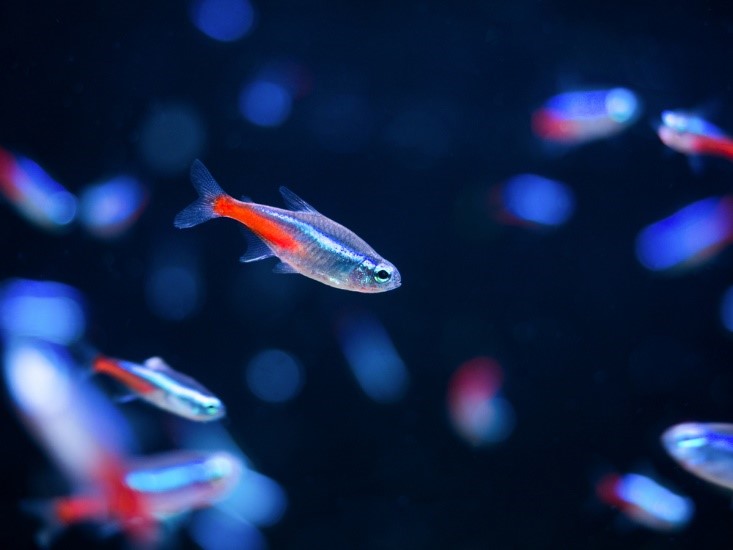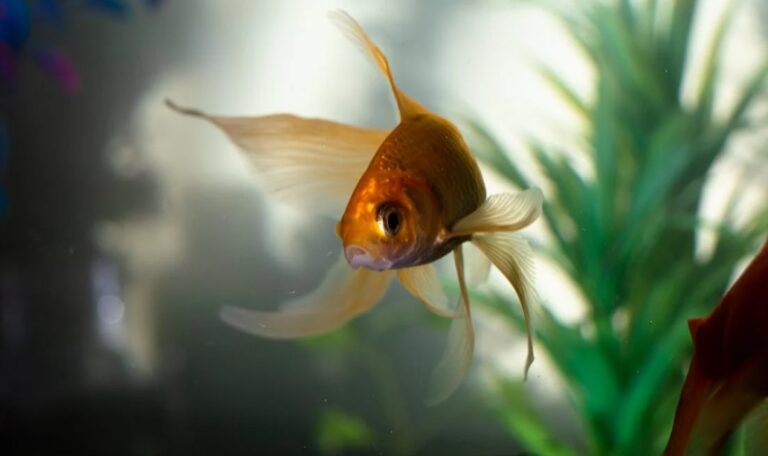Many different types of fish can be kept in an aquarium as pets. However, some are more delicate than others and require high maintenance. On the other hand, others are hardy and low-maintenance, so they are an excellent option for beginners.
Below is a look at the 8 easiest fish to keep and beginner fish keeping mistakes to avoid.
8 Easiest Fish to Take Care Of
1. Goldfish

The common goldfish is a hardy fish that is easy to care for and maintain. It is a cold-water fish, so you do not need a heater. However, you must have a suitable tank size and maintain the water conditions at optimal.
Goldfish tend to release a relatively high amount of waste. Therefore, you require a good-quality filter. You should also change at least 10% of the water each week. They are unforgiving if the water is hard or the PH is high.
Goldfish are easy to feed with fish flakes, spirulina algae, and vegetables. Their most suitable diet is high in carbohydrates and low in protein.
There is a wide variety of goldfish that you can keep as pet fish. Some grow bigger than others. On average, goldfish grow 12-14 inches long. Although most beginners start with a goldfish bowl, it is not ideal for the fish, and you would eventually need to move the fish to a bigger tank. Mature goldfish require about 30 gallons of water per fish to thrive
Harlequin Rasbora

The harlequin rasbora is another great option for beginner aquarists. There are different rasboras fish, but the harlequin rasbora and lambchop rasbora are the most commonly kept species.
The harlequin rasbora stands out for its bright orange color with distinct black triangular patches, providing a beautiful aquarium display. They are a type of nano fish that grow to about 2 inches long. Generally, they are calm, somewhat shy, and peaceful fish, though they are more playful and active if in a group. You can buy them in most pet stores.
The harlequin rasboras are community fish. They thrive best in a school with other harlequin rasboras. Keep them as a school of six or more fish. They also pair well with other fish species, such as other rasboras, dwarf gouramis, danios, mollies, guppies, barbs, tetras, and corydoras catfish.
The recommended tank size is at least 10 gallons, depending on the number of fish you keep. They prefer soft, slightly acidic water with slow movements. They are omnivores and not picky eaters. When properly cared for, these small fish have a lifespan of five to eight years.
Betta Fish

Betta fish are among the easiest fish to take care of. They are beautiful, small, and hardy, making them excellent fish for beginners. However, they are aggressive fish, particularly towards fellow male betta fish.
Due to their fairly aggressive nature, they are also called Siamese fighting fish. Female betta fish can be kept as community fish alongside more peaceful fish, but male bettas are best kept separately.
They are tropical fish that thrive in water temperatures of 78-84F. If kept alone, a 5-gallon tank is sufficient. For small tanks, change 25% of the water weekly. For larger tanks, change the water fortnightly. They are easy to feed with generic fish flakes, betta pellets, small floating worms, and frozen bloodworms.
Neon Tetra

Like the rasboras, tetras are small schooling fish that prefer to live in a community with other neon fish. Keep them in a school of at least six fish. There is a wide variety of tetras, but neon tetras are most commonly kept. They are tropical fish that prefer soft, neutral water.
Dwarf Gourami

Gouramis are a fish species from South and Southeast Asia. While most gouramis are medium or large, dwarf gouramis are small fish. They can live in large groups as they are not aggressive. They are low-maintenance community fish.
You require at least a 10-gallon tank to keep a school of about six dwarf gourami fish. They are carnivorous and feed on brine shrimp and daphnia. They thrive in a water temperature range of 76-84F and a pH of about 5.5-7.0.
Kuhli Loach

Kuhli Loach are eel-like fish. They are shy fish and like to hide behind the decor. However, they are more active in the company of other Kuhli loaches. They also live well with other species, such as zebrafish, neon tetras, red cherry shrimp, guppies, and bronze zorys.
They are bottom dwellers meaning they mostly stay at the bottom of the fish tank. They can grow up to 10 centimeters, so provide them with an adequate tank size to grow in and move around. They like to burrow, requiring adequate amounts of fine substrate. Also, make sure the decorations are not rough or sharp to protect their scaleless skin against scratches.
Regarding feeding, they are scavengers that like to eat leftovers from other fish that drop to the bottom of the tank. As such, they help to keep the substrate clean. They are omnivorous and feed on live foods such as bloodworms and daphnia.
They are tropical fish that thrive in water temperatures of 75-86F and pH levels between 6 and 6.5. They thrive best in black water conditions. Therefore, adding driftwood or water additives to the tank is advisable.
Molly Fish

Molly fish, commonly referred to as mollies, are great fish for beginners as long as you provide favorable living conditions. They are colorful freshwater fish, but you can also find them in seawater as they are highly adaptable.
You require at least a 10-gallon tank and water temperatures between 72F and 78F. They like to hide, so ensure to add décor to provide them with hiding spots. Poor water quality puts them at risk of molly disease.
They are generally peaceful fish, but overcrowding can make them territorial and aggressive. Overall, they have warm personalities. On average, they grow up to 4-4.5 inches, although the sailfin species can grow up to six inches. They are herbivorous, so they eat plant-based foods and algae.
Platy Fish

Platy fish are another type of low-maintenance aquarium fish. They are hardy fish that can tolerate most tank conditions. They can be kept as community fish but in their own company. They are omnivorous and feed on various foods, including live foods, pellets, vegetables, and flakes.
They are colorful fish that come in a variety of colors. They spend most of their time swimming in the fish tank. They need a minimum aquarium size of at least 20 gallons.
6 Mistakes to Avoid for Beginner Fish Keeping
Below are some mistakes to avoid as a beginner in fish keeping
1. Buying the Aquarium Before deciding Which Fish to Keep
The type of fish determines the right tank size and water parameters, depending on its habitat behavior and body size. The right tank size also depends on the number and type of fish you will keep together.
2. Putting the Fish in the Aquarium Right Away
Ideally, you should also not buy the tank at the same time as the fish. You must set up the aquarium and cycle it before putting fish in to help them acclimate faster and better. Otherwise, the fish will die within a few days of putting it in the aquarium.
3. Putting Incompatible Fish Together
Some fish should be kept alone. Others do better in a school of their kind but not too well with other species. Yet, others are great community fish with different species. Therefore, research the various pet fish species to determine which ones would do well together or solely.
4. Overfeeding the Fish
This is one of the most common mistakes by beginner aquarists. You may find it fun to watch the fish swim after the food, so end up offering food frequently. In other cases, you may misjudge that the fish is angry.
Overfeeding is one of the top reasons for fish dying. Most fish require to be fed 2-3 times only. Besides, overfed fish produce more waste which offsets the water quality and tank conditions.
5. Using the Wrong Substrats
Although colored pebbles look more attractive, they contain dye that can harm the fish. On the other hand, gravel cause feces and leftover food to accumulate at the bottom of the tank. It can also scratch the fish’s skin. Excessively fine gravel causes water to be stagnant and to sit at the bottom for too long, which can result in rotting. The best substrate has a medium grain with no artificial colors.
6. Not Adding Live Plants in the Fish Tank
Live plants are not only decorative and provide the fish with hiding places, but they also help in cleaning the tank. They break down ammonia from fish waste to support their growth.
Conclusion
If you are just starting in fish keeping, it is best to go for low-maintenance fish that are hardy and easy to take care of. There is a wide range to choose from, whether you prefer freshwater or saltwater fish. We have highlighted some of the easiest fish to keep, including goldfish, rasboras, neon tetras, and mollies. The key is researching the required conditions for your choice of fish and providing a conducive environment.






